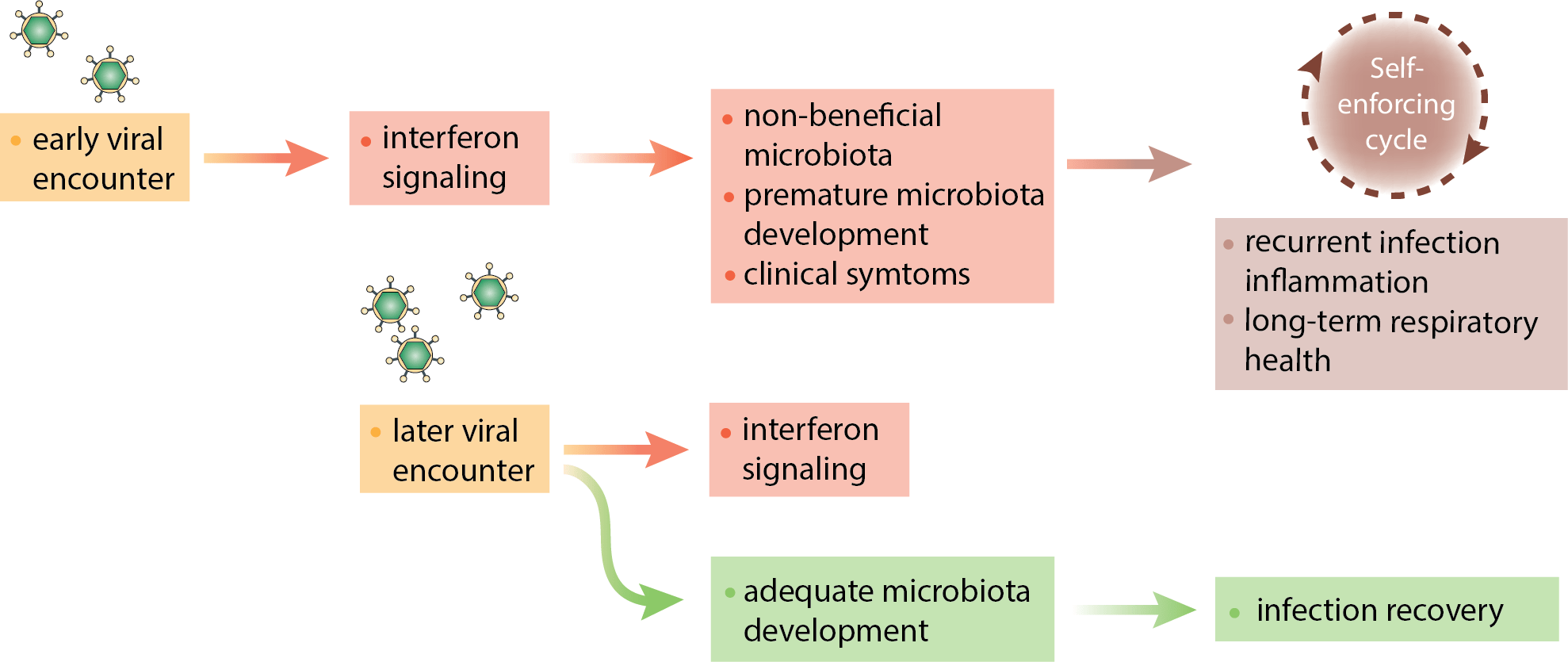Early-life viral infections may increase the risk of respiratory tract infections during the first year of life. This was concluded in the first longitudinal study of upper airway gene expression and microbiota development in infants by an international research group led by professor Debby Bogaert and published in Nature Microbiology.
The respiratory tract is populated by a specialized microbial ecosystem, which is seeded during and immediately after birth. Perturbed development of the respiratory microbial community during early-life has been associated with increased susceptibility to respiratory tract infections (RTIs) later in life. Given that previously a consistent gap was observed in time between first signs of aberrant microbial maturation and an infant experiencing the first RTIs, it was hypothesized that early-life host–microbe cross-talk plays a role in this process. Investigators from the Wilhelmina Children’s Hospital (part of University Medical Center Utrecht), Spaarne Gasthuis (Hoofddorp), the University of Edinburgh (Edinburgh, U.K.) and the National Institute of Public Health and the Environment (Bilthoven), therefore investigated airway mucosal gene expression dynamics in infants over the first year of life in relation to RTI susceptibility. Gene expression data were placed in the context of viral and microbiota data to disentangle airway viral-host-microbe interactions.
The research is part of a series of studies based on the Microbiome Utrecht Infant Study (MUIS), executed by the clinical research facility of the Spaarne Hospital lead by pediatrician Marlies van Houten MD PhD. The researchers found that the strongest dynamics in gene expression (transcriptome) profiles occurred already within the first days of life, mostly involving Toll-like receptor (TLR) and inflammasome signalling. These dynamics co-occurred with rapid development of the airway microbiota. Early-life viral infection, though mostly asymptomatic, coincided with stronger interferon activity, which was related to specific microbiota changes, characterized by enrichment of Gram-negative bacteria, such as Moraxella and Haemophilus spp. This was in turn related to a higher number of subsequent RTIs during the first year of life.
By combining multiple datasets, the researchers provide support for the hypothesis that first viral encounters trigger an interferon-associated pro-inflammatory environment, which selects for specific pathobionts that further drive airway inflammation and symptomatology in a self-enforcing positive feedback loop. This pro-inflammatory and microbiologically perturbed environment in turn renders an individual more vulnerable to recurrent (viral) RTIs.
Wouter de Steenhuijsen Piters MD PhD, a post-doctoral investigator at the Department of Pediatric Immunology and Infectious Diseases (UMC Utrecht) and first author of the paper concluded: “Although further work will be needed to confirm the causality of our findings, the data from this study indicate that early-life encounters with respiratory viruses – especially during the first days of life – may set the tone for subsequent non-beneficial host-microbe interactions, which are related to an infection risk and possibly long term respiratory health.”
“Effect of early versus late viral exposure and risk of infectious disease”
Respiratory tract infections remain a major global health concern, being responsible for 15 percent of childhood deaths under the age of 5 years globally, and for considerable morbidity. Despite recognition of many host and environmental factors known to contribute to RTI susceptibility, such as age, gender, genetics, birth mode, breastfeeding, crowding conditions and environmental tobacco exposure, the exact mechanism(s) by which a child develops recurrent or severe RTIs while others remain healthy, has remained largely unknown. The current publication therefore strongly contributes to a better understanding of the risk of respiratory infection in infants.
Steenhuijsen Piters WAA de, Watson RL, Koff EM de, Hasrat R, Arp K, Chu MLJN, Groot PCM de, Houten MA van, Sanders EAM, Bogaert D. Early-life viral infections are associated with disadvantageous immune and microbiota profiles and recurrent respiratory infections. Nature Microbiology, January 20, 2022 published online

